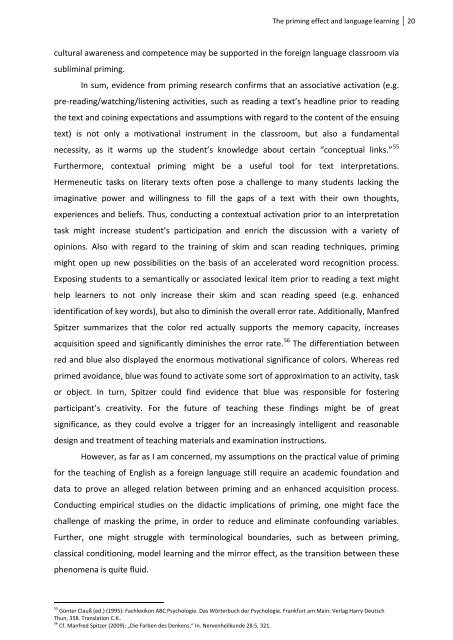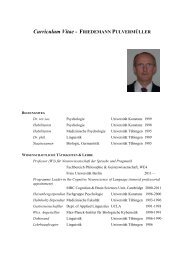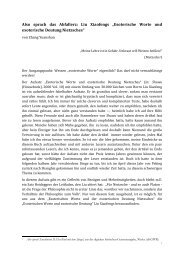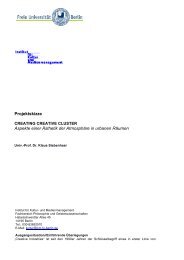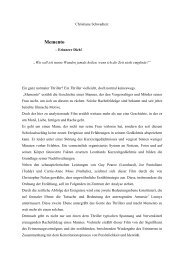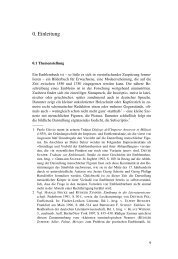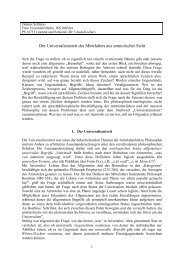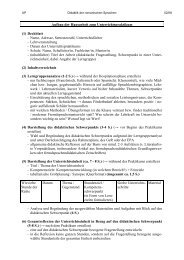3. Priming in action - Fachbereich Philosophie und ...
3. Priming in action - Fachbereich Philosophie und ...
3. Priming in action - Fachbereich Philosophie und ...
Create successful ePaper yourself
Turn your PDF publications into a flip-book with our unique Google optimized e-Paper software.
The prim<strong>in</strong>g effect and language learn<strong>in</strong>g 20<br />
cultural awareness and competence may be supported <strong>in</strong> the foreign language classroom via<br />
sublim<strong>in</strong>al prim<strong>in</strong>g.<br />
In sum, evidence from prim<strong>in</strong>g research confirms that an associative activation (e.g.<br />
pre-read<strong>in</strong>g/watch<strong>in</strong>g/listen<strong>in</strong>g activities, such as read<strong>in</strong>g a text’s headl<strong>in</strong>e prior to read<strong>in</strong>g<br />
the text and co<strong>in</strong><strong>in</strong>g expectations and assumptions with regard to the content of the ensu<strong>in</strong>g<br />
text) is not only a motivational <strong>in</strong>strument <strong>in</strong> the classroom, but also a f<strong>und</strong>amental<br />
necessity, as it warms up the student’s knowledge about certa<strong>in</strong> “conceptual l<strong>in</strong>ks.” 55<br />
Furthermore, contextual prim<strong>in</strong>g might be a useful tool for text <strong>in</strong>terpretations.<br />
Hermeneutic tasks on literary texts often pose a challenge to many students lack<strong>in</strong>g the<br />
imag<strong>in</strong>ative power and will<strong>in</strong>gness to fill the gaps of a text with their own thoughts,<br />
experiences and beliefs. Thus, conduct<strong>in</strong>g a contextual activation prior to an <strong>in</strong>terpretation<br />
task might <strong>in</strong>crease student’s participation and enrich the discussion with a variety of<br />
op<strong>in</strong>ions. Also with regard to the tra<strong>in</strong><strong>in</strong>g of skim and scan read<strong>in</strong>g techniques, prim<strong>in</strong>g<br />
might open up new possibilities on the basis of an accelerated word recognition process.<br />
Expos<strong>in</strong>g students to a semantically or associated lexical item prior to read<strong>in</strong>g a text might<br />
help learners to not only <strong>in</strong>crease their skim and scan read<strong>in</strong>g speed (e.g. enhanced<br />
identification of key words), but also to dim<strong>in</strong>ish the overall error rate. Additionally, Manfred<br />
Spitzer summarizes that the color red actually supports the memory capacity, <strong>in</strong>creases<br />
acquisition speed and significantly dim<strong>in</strong>ishes the error rate. 56 The differentiation between<br />
red and blue also displayed the enormous motivational significance of colors. Whereas red<br />
primed avoidance, blue was fo<strong>und</strong> to activate some sort of approximation to an activity, task<br />
or object. In turn, Spitzer could f<strong>in</strong>d evidence that blue was responsible for foster<strong>in</strong>g<br />
participant’s creativity. For the future of teach<strong>in</strong>g these f<strong>in</strong>d<strong>in</strong>gs might be of great<br />
significance, as they could evolve a trigger for an <strong>in</strong>creas<strong>in</strong>gly <strong>in</strong>telligent and reasonable<br />
design and treatment of teach<strong>in</strong>g materials and exam<strong>in</strong>ation <strong>in</strong>structions.<br />
However, as far as I am concerned, my assumptions on the practical value of prim<strong>in</strong>g<br />
for the teach<strong>in</strong>g of English as a foreign language still require an academic fo<strong>und</strong>ation and<br />
data to prove an alleged relation between prim<strong>in</strong>g and an enhanced acquisition process.<br />
Conduct<strong>in</strong>g empirical studies on the didactic implications of prim<strong>in</strong>g, one might face the<br />
challenge of mask<strong>in</strong>g the prime, <strong>in</strong> order to reduce and elim<strong>in</strong>ate confo<strong>und</strong><strong>in</strong>g variables.<br />
Further, one might struggle with term<strong>in</strong>ological bo<strong>und</strong>aries, such as between prim<strong>in</strong>g,<br />
classical condition<strong>in</strong>g, model learn<strong>in</strong>g and the mirror effect, as the transition between these<br />
phenomena is quite fluid.<br />
55<br />
Günter Clauß (ed.) (1995): Fachlexikon ABC Psychologie. Das Wörterbuch der Psychologie. Frankfurt am Ma<strong>in</strong>: Verlag Harry Deutsch<br />
Thun, 358. Translation C.K..<br />
56<br />
Cf. Manfred Spitzer (2009): „Die Farben des Denkens.“ In. Nervenheilk<strong>und</strong>e 28.5, 321.


